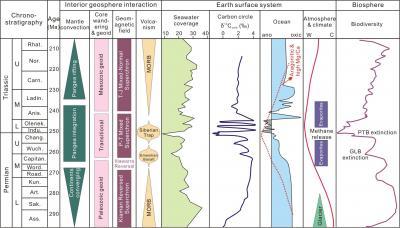Supercontinents have formed and broken apart throughout the geological history of Earth (see Rodinia) and about 300 million years ago, the Pangaea supercontinent was cobbled together.
While we generally attribute some instances of animal and plants existence in isolated areas to splitting continents, researchers in a new paper have instead linked Pangaea being formed to the largest mass extinction known, the Permian extinction, when up to 95% of species, 82% of genera and over 50% of families became extinct.
The Pangaea was integrated at about the beginning of Permian, its formation meant that the scattered continents of the world gathered into one integrated continent with an area of nearly 200 million square kilometers. The average thickness of such a giant continental lithosphere should be remarkably greater than that of each scattered continent and the equilibrium principle implies that the thicker the lithosphere, the higher its portion over the equilibrium level, hence the average altitude of the Pangaea should be much higher than the separated modern continents.
A single continent brought a single ocean around it, now named the Panthalassa, which should have been much deeper than modern oceans. High continents and a deeper ocean should induce great regression and influence the earth's surface system, like the climate.

Relationships between geosphere disturbances and mass extinction during the Late Permian and Early Triassic are shown. Credit: Science China Press
The Tunguss Trap of Siberia, the Emeishan Basalt erupted during the Pangea integration. They say that global-scale volcanism meant volcanic activities would result in a series of extinction effects, including emission of large volume of CO2, CH4, NO2 and cyanides which would have caused greenhouse effects, pollution by poisonous gases, damage of the ozone layer in the stratosphere and enhancement the ultra-violet radiation.
Increase of CO2 concentration and other green house gases would have led to "global warming", oxygen depletion and a carbon cycle anomaly; physical and chemical anomalies in ocean (acidification, euxinia, low sulfate concentration, isotopic anomaly of organic nitrogen) and great regression would have caused marine extinction due to unadaptable environments, selective death and hypercapnia; continental aridity, disappearance of monsoon system and wild fire would have devastated the land vegetation, esp. the tropical rain forest.

DOI: 10.1007/s11430-013-4624-3
These global changes and mass extinction were the results of interaction among earth's spheres; as the lithosphere, atmosphere, hydrosphere, and biosphere came into greater conflict during the Permian-Triassic transition time and extinction occurred, the authors hypothesize.
Causation is always difficult, of course, but it's an interesting concept to study.




Comments